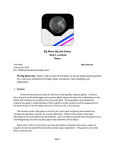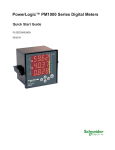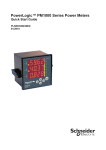Download 1 User`s Manual for Star Chart Plot Program Prepared by Toshimi
Transcript
1 User’s Manual for Star Chart Plot Program Prepared by Toshimi Taki March 26, 2008 1. Introduction “Star Chart Plot Program” is designed for making star charts to be printed on paper. It was used to make “Taki’s Star Atlas”, “Taki’s 8.5 Magnitude Star Atlas” and “Atlas of Double Stars”. The program and the example data file for Atlas of Double Stars are available in my homepage, http://www.asahi-net.or.jp/~zs3t-tk/. This manual shows instruction to use “Star Chart Plot Program”. 2. Features The program has the following features. User can define: Paper size. Chart scale Right ascension/declination grid plot Stars and their labels Diameter scale of star symbols Deep sky objects and their labels Constellation border plot Ecliptic line plot Galactic equator plot The chart is editable manually. The labels can be adjusted manually. Projection method is modified Mercator projection only. 3. Overview of Program “Star Chart Plot Program” requires MS-PowerPoint and MS-Excel. The input data is prepared in MS-Excel file. The macros in MS-PowerPoint read the Excel file and plot Right Ascension/Declination grid, stars, deep sky objects, etc on slides. Users need to combine all the plotted objects in the slides and edit the objects to complete the chart. 4. Input Data File The Excel input data file consists of seven (7) worksheets. 2 “setting” This worksheet defines basic setting of the chart (size of paper, chart scale, chart center) and right ascension/declination grid. Right ascension and declination should be expressed in degree. “star” This worksheet defines data of stars (position, magnitude, type and name). Right ascension and declination should be expressed in degree. Multiple stars are marked with “x” in column H. Variable stars are marked with “v” in column J. The star data should be sorted with magnitude in ascending order. It also defines scale of plotted diameter of stars. Explanation of star diameter scale is shown in the figure below. User can adjust the parameters of the plot diameter-magnitude scaling. This feature is very useful to express realistic brightness. Sine Curve The diameter of a star on the chart is defined as follows. Diameter dia0 dia0: diameter for 0-magnitude star dia1: diameter for m1-magnitude star dia1 mp: star magnitude at maximum star diameter mv: star magnitude at minimum star diameter mp 0 m1 mv Magnitude “deep_sky” This worksheet defines data of deep sky objects (position, size, position angle (PA) of major axis, and type). Right ascension and declination should be expressed in degree. The size of deep sky objects should be expressed in arc minute. “constellation” This worksheet defines data of constellation border. Right ascension and declination of segments of constellation borders should be expressed in degree. “ecliptic” This worksheet defines ecliptic line. Right ascension and declination of segments of ecliptic line and tick marks should be expressed in degree. “galactic” This worksheet defines data of galactic plane. Right ascension and declination of segments of 3 galactic line should be expressed in degree. “galactic_tick” This worksheet defines data of tick marks for galactic plane. The data should be expressed in degree. A sample data file which was used for “Atlas of Double Stars” is provided and yellow cells in the worksheets should be filled out by users. The file name of the input data file should be “data.xls” and the file should be stored in c: drive (c:¥data.xls). 5. Macros in MS-PowerPoint Files Two files are provided, one (star_chart_template.ppt) is for charts which do not include the south pole and another file (star_chart_template_southpole.ppt) is for charts which include the south pole. Both files contain the following Macros. “a_grid” Plot right ascension/declination grid. “b_star” Plot stars. “c_star_name” Plot star labels. “d_deep_sky” Plot deep sky objects. “e_deep_sky_name” Plot labels of deep sky objects. “f_constellation” Plot constellation borders. “g_ecliptic” Plot ecliptic line. “h_galactic” Plot galactic plane. 6. Instruction (1) Prepare data file Modify the sample data file and save the file as “data.xls” in C:¥. 4 (2) PowerPoint file Open PowerPoint template file If you use the other paper size than A-4, change paper size. Insert a new slide. Run macro “a_grid”. Delete the grid lines outside of the frame. Combine all objects in a group. Insert a new slide. Run macro “b_star”. Delete the frame. Combine all objects in a group. Insert a new slide. Run macro “c_star_name”. Delete the frame. Insert a new slide. Run macro “d_deep_sky”. Delete the objects outside of the frame. Delete the frame. Combine all objects in a group. Insert a new slide. Run macro “e_deep_sky_name”. Delete the frame. Insert a new slide. Run macro “f_constellation”. Delete the line segments outside of the frame. Delete the frame. Combine all objects in a group. Insert a new slide. Run macro “g_ecliptic”. Delete the line segments outside of the frame. Delete the frame. Combine all objects in a group. Insert a new slide. Run macro “h_galactic”. Delete the line segments outside of the frame. Delete the frame. Combine all objects in a group. Insert a new slide. Copy the above objects and paste them in the new slide. Adjust the position of the labels of stars and deep sky objects. Add other information such as grid labels and title. Save the file.
















